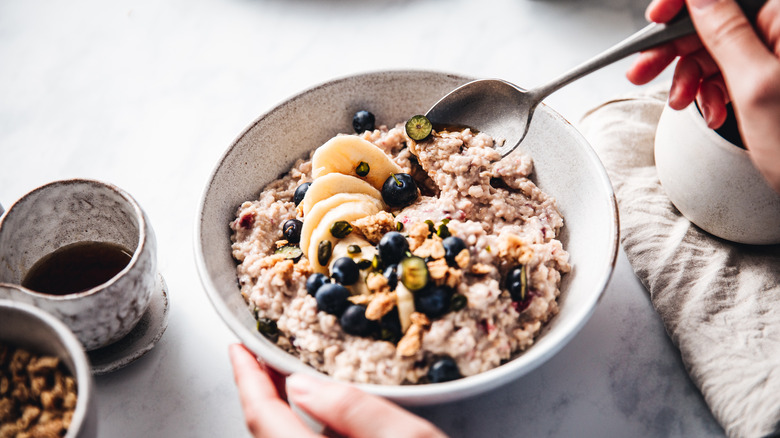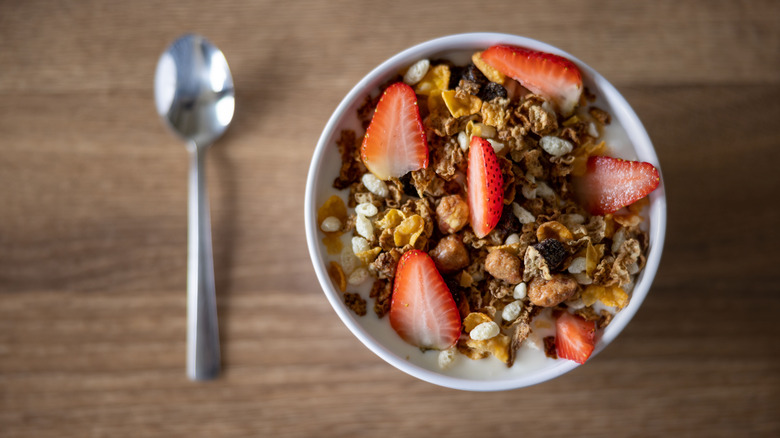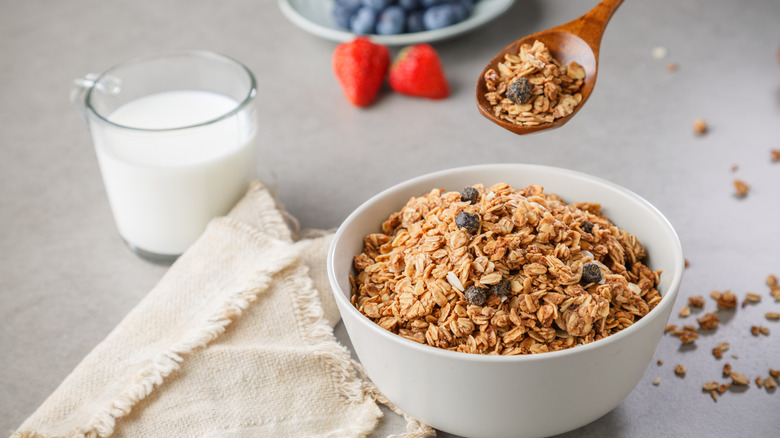Muesli Vs Granola: The Difference Between These Oat-Based Cereals
Sometimes, you just don't have the energy to make a full eggs and bacon breakfast, or pancakes... or anything that requires the stove. On those days, you want something quick and easy — and that's when you reach for your favorite box of cereal. Cereal as a breakfast category can be a tad misunderstood. Most people hear that term and think of a bowl of corn-based flakes covered in sugar or frosting, but there are plenty of other options that fit into that group. One of which you're likely familiar with is granola, an oat-based concoction that often comes in chewy bar form.
But granola is not the only oat-based cereal. There's also muesli, which despite being quite similar to granola, is not the same thing. Both are oat-based mixtures designed to balance some sweetness with the mild flavor of oats. There are a couple of differences between these two cereals, but the biggest one that stands above all others is that granola is cooked, while muesli is raw.
They have the same ingredients, but are eaten differently
Granola and muesli have enough similarities to be categorized together in the realm of cereal. They both typically consist of rolled oats (although sometimes you'll find muesli made with millet) and nuts like walnuts, almonds, or cashews. Additionally, you'll see dried fruit like raisins, apricots, dates or cranberries, and some kind of seed (chia and flax are the most common). When making them at home, granola and muesli are both infinitely customizable, which makes them a highly personalized breakfast choice.
But while the ingredients may be roughly the same, the preparation for the two isn't. Granola is sweetened, baked, and crumbled, which is what gives it that hard, crunchy texture, and clumped-together consistency. It's often served with milk as a counterbalance to this, or on top of yogurt, and almost always eaten cold. Muesli, meanwhile, is by definition raw and loose. You can eat muesli straight up or with milk, like granola, or boil it to create a porridge-like slurry. However, the most common preparation is to soak muesli overnight in milk, yogurt, or juice and eat it cold (like Bircher muesli, which is said to be the original version of overnight oats).
One is common in Europe, while one is common in the U.S.
The different geographical origins of muesli and granola explain their popularity in different regions. Muesli is popular in Europe, while granola is popular in America. Muesli was created by a Swiss doctor named Maximilian Oskar Bircher-Benner around 1900 as a means of creating a nutritious, raw-food dinner that was easy to digest for his sanatorium patients. The original Bircher muesli was served with grated apple and chopped nuts.
Granola, meanwhile, dates back a bit further than muesli, as it was created in 1863 in New York by a doctor named James Caleb Jackson, who called it "granula." John Harvey Kellogg soon started selling his own kind of granula, but after the threat of a legal dispute, changed the name to granola. Granola didn't truly take off until the 1960s, which was when it started being marketed as a health food after the addition of nutritious ingredients like fruit and nuts. Granola has been popular in America ever since.


